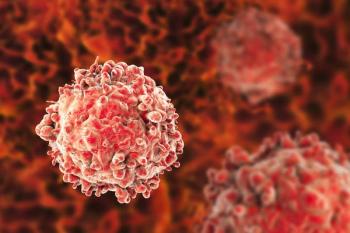
Nivolumab Plus Chemotherapy Enhances Responses, Is Well Tolerated in Hodgkin Lymphoma

Adult and pediatric oncology collaboration in assessing nivolumab in advanced Hodgkin lymphoma facilitated the phase 3 SWOG S1826 findings.
Collaboration between adult and pediatric oncology groups in the phase 3 SWOG S1826 (NCT03907488) might have helped expedite trial findings, according to Andrew M. Evens, DO, MBA, MSc.
CancerNetwork spoke with Evens, deputy director for clinical services at the Rutgers Cancer Institute and system director of medical oncology and oncology lead at RWJBarnabas Health Medical Group, about prominent lymphoma trials related to adolescents and young adults (AYA). Evens highlighted efficacy and safety findings from the phase 3 SWOG S1826 trial.
He began by introducing the trial, which was conducted to evaluate nivolumab (Opdivo) plus AVD (doxorubicin hydrochloride [Adriamycin], vinblastine sulfate, and dacarbazine) against the standard-of-care brentuximab vedotin (Adcetris) plus AVD in patients with advanced-stage Hodgkin lymphoma. He expressed that the trial was the first of its kind in that it was open across pediatric and adult oncology centers across North America.
Evens expressed that the trial results were a “double winner,” explaining that progression-free survival (PFS) was over 90% with lower AE incidence experienced with nivolumab over brentuximab vedotin, which was reflected 1 year before the 2-year PFS updates were published. He highlighted the collaboration between adult and pediatric centers, which enabled the trial to be conducted that elicited favorable efficacy and safety results in a timely fashion.
According to data from the phase 3 SWOG S1826 trial, PFS was significantly improved with nivolumab plus AVD versus brentuximab vedotin plus AVD with a hazard ratio of disease progression or death of 0.48 (99% CI, 0.27-0.87; 2-sided P = .001). Additionally, 1-year PFS was 94% (95% CI, 91%-96%) with the nivolumab combination therapy vs 86% (95% CI, 82%-90%) and 2-year PFS was 92% (95% CI, 89%-94%) and 83% (95% CI, 79%-86%), respectively. Additionally, high-grade adverse events (AEs) were higher in the brentuximab vedotin group except for neutropenia.
Transcript:
The acronym or numbering of the trial was SWOG S1826 (NCT03907488). This was a first-of-its-kind study, at least in the modern era, where on the same phase 3 clinical trial, much less any clinical trial, it was open across pediatric and adult oncology centers across [...] North America. It was for patients with untreated or newly diagnosed advanced-stage classical Hodgkin lymphoma, so advanced stage III and IV.
More recently, the standard of care that had broken through strongly on the adult side of the aisle was taking a targeted agent, brentuximab vedotin, replacing a chemotherapy drug, bleomycin, and using 3 other chemotherapy drugs [doxorubicin hydrochloride (Adriamycin), vinblastine sulfate, and dacarbazine], AVD, had really broken through. The standard for 20 years before that was a chemotherapy regimen called ABVD; 4 letters, 4 chemotherapy drugs. By replacing the bleomycin with brentuximab vedotin, AAVD, that had really been the standard.
We sought to beat that, and a new clinical trial was designed several years ago, led by SWOG, but included all the adult [and pediatric] groups using an immunotherapy approach with nivolumab instead of [brentuximab vedotin]. It was nivolumab, or NAVD, vs AAVD.
You could say it was, generally speaking, a double winner. It was more effective at 2 years, the progression-free survival [PFS] was greater than 90%, so a remarkable output. When I say a double winner, it was also largely better tolerated. There was less neuropathy, [fewer] infections, less sepsis, etc, and surprisingly, to a certain extent, not many immune-related adverse events outside of thyroid [events]. I would submit overnight with that publication, and we knew about it a year ago at the 1-year update. This was a 2-year PFS update in the New England Journal of Medicine.
That is an important breakthrough that highlights the collaboration, because if we would have done that trial separately, the adult and pediatric group, it might have taken twice as long or never even happened. Now it happens, and it transcends all the different age groups.
Reference
Herrera AF, LeBlanc M, Li H, et al. Nivolumab+AVD in advanced-stage classic Hodgkin’s lymphoma. N Engl J Med. 2024;391(15):1379-1389. doi:10.1056/NEJMoa2405888
Newsletter
Stay up to date on recent advances in the multidisciplinary approach to cancer.
































































































